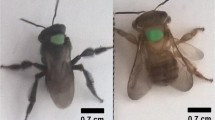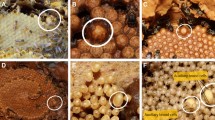Abstract
The spectacular morphological variation among workers of certain ant and termite species has fascinated evolutionary biologists since Darwin. In some species, environmental triggers induce larvae to develop into different phenotypes, e.g. minor or major workers (soldiers). Recently, the first soldier subcaste was discovered in a bee, the stingless bee Tetragonisca angustula. In contrast to ants, which raise their offspring by progressively feeding larvae until the pupal stage, T. angustula nurses mass provision individual brood cells after which the bees develop from egg to young workers in sealed cells on a seemingly uniform brood comb. This prompts the question of how this bee creates a morphologically variable workforce without larvae having direct contact with nursing workers. We investigated where T. angustula raises a larger soldier subcaste on its compact brood comb. Additionally, we examined whether size differences among workers could be generated by differential distribution of food by nursing workers. We found that colonies produce c. 1–6 % of soldier-sized workers, which mainly emerge from a small central area of the comb. In this area, cells are wider and a larger number of nursing bees unload larval food here before oviposition. Cell attendance levels prior to oviposition were similar across the comb and, thus, did not explain the larger food volumes found in the centre. Our results suggest that workers determine soldier production via larval food discharges and cell-building behaviour. Nutritional differences among larvae might then induce larvae into one or the other caste developmental pathway.





Similar content being viewed by others
References
Anderson C, McShea DW (2001) Individual versus social complexity, with particular reference to ant colonies. Biol Rev 76:211–237
Bego LR, Grosso AF, Zucchi R, Sakagami SF (1999) Oviposition behavior of the stingless bees XXIV. Ethological relationships of Tetragonisca angustula angustula to other Meliponinae taxa (Apidae: Meliponinae). Entomol Sci 2:473–482
Couvillon MJ, Dornhaus A (2009) Location, location, location: larvae position inside the nest is correlated with adult body size in worker bumble-bees (Bombus impatiens). Proc R Soc B 276:2411–2418
Couvillon MJ, Segers FHID, Cooper-Bowman R, Truslove G et al (2013) Context affects nestmate recognition errors in honey bees and stingless bees. J Exp Biol 216:3055–3061
Emlen DJ, Nijhout HF (2000) The development and evolution of exaggerated morphologies in insects. Annu Rev Entomol 45:661–708
Evans JD, Wheeler DE (2001) Gene expression and the evolution of insect polyphenisms. Bioessays 23:62–68
Evison SEF, Hughes WO (2011) Genetic caste polymorphism and the evolution of polyandry in Atta leaf-cutting ants. Naturwissenschaften 98:643–649
Fjerdingstad EJ, Crozier RH (2006) The evolution of worker caste diversity in social insects. Am Nat 167:390–400
Goulson D (2010) Bumblebees: behaviour, ecology, and conservation (No. Ed. 2). Oxford University Press.
Goulson D, Derwent LC, Peat J (2005) Evidence for alloethism in stingless bees (Meliponinae). Apidologie 36:411–412
Grüter C, Kärcher MH, Ratnieks FLW (2011) The natural history of nest defence in a stingless bee, Tetragonisca angustula (Latreille) (Hymenoptera: Apidae), with two distinct types of entrance guards. Neotrop Entomol 40:55–61
Grüter C, Menezes C, Imperatriz-Fonseca VL, Ratnieks FL (2012) A morphologically specialized soldier caste improves colony defense in a neotropical eusocial bee. Proc Natl Acad Sci 109:1182–1186
Hartfelder K, Makert GR, Judice CC, Pereira GA, Santana WC, Dallacqua R, Bitondi MM (2006) Physiological and genetic mechanisms underlying caste development, reproduction and division of labor in stingless bees. Apidologie 37:144
Harvell CD (1994) The evolution of polymorphism in colonial invertebrates and social insects. Q Rev Biol 69:155–185
Hasegawa E (1997) The optimal caste ratio in polymorphic ants: estimation and empirical evidence. Am Nat 706–722
Hölldobler B, Wilson EO (1990) The ants. Harvard Belknap, Cambridge
Huang ZY, Otis GW (1991) Inspection and feeding of larvae by worker honey bees (Hymenoptera: Apidae): effect of starvation and food quantity. J Insect Behav 4:305–317
Hughes WO, Sumner S, Van Borm S, Boomsma JJ (2003) Worker caste polymorphism has a genetic basis in Acromyrmex leaf-cutting ants. Proc Natl Acad Sci 100:9394–9397
Jandt JM, Dornhaus A (2009) Spatial organization and division of labour in the bumblebee Bombus impatiens. Anim Behav 77:641–651
Jones SM, van Zweden JS, Grüter C, Menezes C et al (2012) The role of wax and resin in the nestmate recognition system of a stingless bee, Tetragonisca angustula. Behav Ecol Sociobiol 66:1–12
Koedam D, Broné M, van Tienen PGM (1997) The regulation of worker-oviposition in the stingless bee Trigona (Tetragonisca) angustula Illiger (Apidae, Meliponinae). Insects Soc 44:229–244
Lefeuve P, Bordereau C (1984) Soldier formation regulated by a primer pheromone from the soldier frontal gland in a higher termite, Nasutitermes lujae. Proc Natl Acad Sci 81:7665–7668
McGlynn TP, Diamond SE, Dunn RR (2012) Tradeoffs in the evolution of caste and body size in the hyperdiverse ant genus Pheidole. PLoS One 7:e48202
Michener CD (2007) The bees of the world (2nd edition). JHU Press
Moo-Valle H, Quezada-Euán JJ, Wenseleers T (2001) The effect of food reserves on the production of sexual offspring in the stingless bee Melipona beecheii (Apidae, Meliponini). Insects Soc 48:398–403
Noirot CH, Pasteels JM (1987) Ontogenetic development and evolution of the worker caste in termites. Experientia 43:851–860
Oster GF, Wilson EO (1978) Caste and ecology in the social insects. Princeton University Press
Ottoni EB (2000) EthoLog 2.2: a tool for the transcription and timing of behavior observation sessions. Behav Res Methods Instrum Comput 32:446–449
Passera L, Roncin E, Kaufmann B, Keller L (1996) Increased soldier production in ant colonies exposed to intraspecific competition. Nat 379:630–631
Prato M, Soares AEE (2013) Production of sexuals and mating frequency in the stingless bee Tetragonisca angustula (Latreille) (Hymenoptera, Apidae). Neotrop Entomol 42:474–482
Quezada-Euán JJG, López-Velasco A, Pérez-Balam J, Moo-Valle H, Velazquez-Madrazo A, Paxton RJ (2011) Body size differs in workers produced across time and is associated with variation in the quantity and composition of larval food in Nannotrigona perilampoides (Hymenoptera, Meliponini). Insects Soc 58:31–38
R Development Core Team (2009) R: a language and environment for statistical computing. R Foundation for Statistical Computing, Vienna, Austria
Radmacher S, Strohm E (2010) Factors affecting offspring body size in the solitary bee Osmia bicornis (Hymenoptera, Megachilidae). Apidologie 41:169–177
Rajakumar R et al (2012) Ancestral developmental potential facilitates parallel evolution in ants. Sci 335:79–82
Ramalho M, Imperatriz-Fonseca VL, Giannini TC (1998) Within-colony size variation of foragers and pollen load capacity in the stingless bee Melipona quadrifasciata anthidioides Lepeletier (Apidae, Hymenoptera). Apidologie 29:221–228
Roulston TAH, Cane JH (2000) The effect of diet breadth and nesting ecology on body size variation in bees (Apiformes). J Kansas Entomol Soc 129–142
Shibao H, Kutsukake M, Fukatsu T (2004) Density-dependent induction and suppression of soldier differentiation in an aphid social system. J Insect Physiol 50:995–1000
Shingleton AW, Frankino WA, Flatt T, Nijhout HF, Emlen D (2007) Size and shape: the developmental regulation of static allometry in insects. BioEssays 29:536–548
Shpigler H, Tamarkin M, Gruber Y, Poleg M, Siegel AJ, Bloch G (2013) Social influences on body size and developmental time in the bumblebee Bombus terrestris. Behav Ecol Sociobiol 67:1601–1612
Smith CR, Toth AL, Suarez AV, Robinson GE (2008) Genetic and genomic analyses of the division of labour in insect societies. Nat Rev Genet 9:735–748
Spaethe J, Brockmann A, Halbig C, Tautz J (2007) Size determines antennal sensitivity and behavioural threshold to odors in bumblebee workers. Naturwissenschaften 94:733–739
Spradbery JP (1973) Wasps. University of Washington Press, Seattle
Stern DL, Foster WA (1996) The evolution of soldiers in aphids. Biol Rev 71:27–79
Strassmann J (2001) The rarity of multiple mating by females in the social Hymenoptera. Insects Soc 48:1–13
Tian L, Zhou X (2014) The soldiers in societies: defense, regulation and evolution. Int J Biol Sci 10:296–308
Tóth E, Queller DC, Dollin A, Strassmann JE (2004) Conflict over male parentage in stingless bees. Insectes Soc 51:1–11
Tschinkel WR (1998) Sociometry and sociogenesis of colonies of the harvester ant, Pogonomyrmex badius: worker characteristics in relation to colony size and season. Insects Soc 45:385–410
van Zweden JS, Grüter C, Jones SM, Ratnieks FL (2011) Hovering guards of the stingless bee Tetragonisca angustula increase colony defensive perimeter as shown by intra-and inter-specific comparisons. Behav Ecol Sociobiol 65:1277–1282
Waddington KD, Herbst LH, Roubik DW (1986) Relationship between recruitment systems of stingless bees and within-nest worker size variation. J Kansas Entomol Soc 95–102
Wheeler DE (1986) Developmental and physiological determinants of caste in social Hymenoptera: evolutionary implications. Am Nat 13–34
Wheeler DE (1991) The developmental basis of worker caste polymorphism in ants. Am Nat 1218–1238
Wheeler DE, Nijhout HF (1981) Soldier determination in ants: new role for juvenile hormone. Sci 213:361–363
Wheeler DE, Nijhout HF (1984) Soldier determination in Pheidole bicarinata: inhibition by adult soldiers. J Insect Physiol 30:127–135
Wille A (1983) Biology of the stingless bees. Ann Rev Entomol 28:41–64
Winston ML (1991) The biology of the honey bee. Harvard University Press
Wittmann D (1985) Aerial defense of the nest by workers of the stingless bee Trigona (Tetragonisca) angustula (Latreille) (Hymenoptera: Apidae). Behav Ecol Sociobiol 16:111–114
Yang AS, Martin CH, Nijhout HF (2004) Geographic variation of caste structure among ant populations. Curr Biol 14:514–519
Zuur A, Ieno EN, Walker N, Saveliev AA, Smith GM (2009) Mixed effects models and extensions in ecology with R. Springer
Acknowledgments
We thank Francis Ratnieks and Fabio Nascimento for logistic support. Many thanks to Benedikt Hammel for recording videos. C.G. was funded by a Science Without Borders fellowship from the Brazilian National Council for Scientific and Technological Development (CNPq) (Process-number: 400664/2012-7) and an Ambizione Fellowship from the Swiss National Science Foundation (PZOOP3_142628/1). AVN was funded by the Fundação de Amparo à Pesquisa do Estado de São Paulo (FAPESP) (2012/11144-0).
Author information
Authors and Affiliations
Corresponding author
Additional information
Communicated by C. Grozinger
Rights and permissions
About this article
Cite this article
Segers, F.H.I.D., Menezes, C., Vollet-Neto, A. et al. Soldier production in a stingless bee depends on rearing location and nurse behaviour. Behav Ecol Sociobiol 69, 613–623 (2015). https://doi.org/10.1007/s00265-015-1872-6
Received:
Revised:
Accepted:
Published:
Issue Date:
DOI: https://doi.org/10.1007/s00265-015-1872-6




